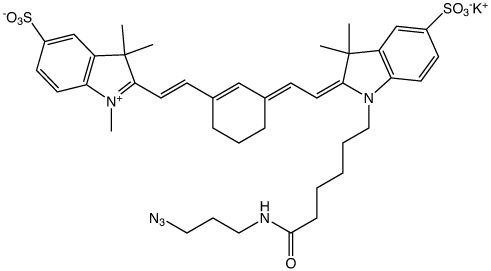Glen Report 26.28: New Product - Disulfo-Cyanine 7 Azide
Near infrared fluorescent dyes (NIR) are fluorophores that absorb and emit light in the near infrared range between 600-1000nm. The usable range within biological systems is between 650nm and 900nm since hemoglobin absorbs below 650nm and water absorbs above 900nm. For NIR imaging, the ideal range is between 750nm-900nm, as biological tissues may also auto-fluoresce, contributing to high background that reduces sensitivity.

(5) Disulfo-Cyanine 7 Azide
Several dyes are available for use within this range and a common cyanine dye, indocyan green (ICG), is an FDA approved fluorescent dye for bioimaging. As a fluorescent indicator, ICG has been used for bioimaging in a number of applications including optometry, cancer screening, lymphatic visualization and whole body animal imaging.
There are several advantages of using NIR for bioimaging including the absence of ionizing radiation, low background fluorescence from biological tissues, capability for real-time monitoring, and deep tissue penetration. Cyanine dyes are particularly attractive as NIR dyes as they are very bright with high extinction coefficients and quantum yields.
Glen Research offers several cyanine-based phosphoramidites that may be useful in NIR imaging including Cyanine 5 with emission at 662nm and Cyanine 5.5 with emission at 707nm. These cyanine phosphoramidites lack the sulfo-groups that help prevent aggregation and promote solubility in aqueous solutions. To better address applications in NIR imaging, Glen Research is offering a water soluble Disulfo-Cyanine 7 azide, (5) in Figure 7, that can be easily conjugated to DNA and RNA through standard click chemistry. This long wavelength dye offers the benefits of improved solubility, reduced aggregation, and improved stability in the near-infrared spectrum along with the convenience of click chemistry.
Disulfo-Cyanine 7 azide has an excitation maximum of 750nm and an emission maximum of 773 nm. Typical click reactions are performed in aqueous solution in 15-60 minutes using our water-soluble THPTA click ligand. We foresee the use of this dye in applications requiring real-time imaging and tracking of NIR-labelled oligonucleotides.
Ordering Information
Disulfo-Cyanine 7 Azide (50-2010) has been discontinued.
- Glen Report 26.21: Reversible M6A RNA Modification
- Glen Report 26.22: New Product - N6-Me-A -Reversible M6A RNA Modification
- Glen Report 26.23: New Product - 5'-Carboxy-Modifier C5
- Glen Report 26.24: DNA-Mediated Charge Transport: A Novel Property of DNA with Diverse Applications
- Glen Report 26.25: New Product - Methylene Blue NHS Ester
- Glen Report 26.26: Technical Brief - Which 3'-Amino-Modifier?
- Glen Report 26.27: Technical Brief – Use of Click Chemistry for Possible Crosslinking, Click Synthesis of a Potentially Useful azido support and New Click Product - Cyanine 7 Azide
- Glen Report 26.28: New Product - Disulfo-Cyanine 7 Azide

